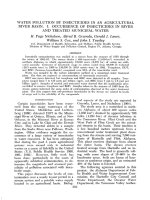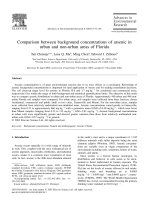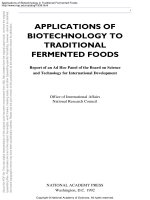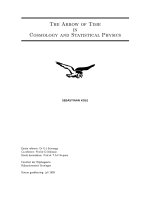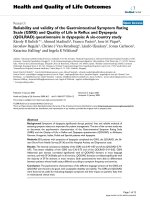Bài giảng - Applications of microbes in environment and agriculture
Bạn đang xem bản rút gọn của tài liệu. Xem và tải ngay bản đầy đủ của tài liệu tại đây (2.07 MB, 22 trang )
Applications of Microorganisms
in Agriculture and Environment
Applications of
Microorganisms in
Environment
Bioremediation
is the use of microorganism metabolism
to remove pollutants
We Use Existing Microbes
To clean up oil spills
Decomposition by Microbes
Components of agent orange
Figure 27.8
We Use Existing Microbes
To leach ores
In addition to the oxidation of sulfur and sulfur
compounds Thiobacillus ferrooxidans is able
to oxidize ferrous to ferric iron and so derive
its energy from this exergonic reaction
2Fe++ + 2H+ + ½O2 ----> 2Fe+++ + H20
2Fe+++ + 6H20 ----> 2Fe(OH)3 + 6H+
2Fe++ + 5H20 + ½O2 ----> 2Fe(OH)3 + 4H+
Wastewater treatment
Anaerobic Sludge Digester
CO2 + 4 H2 CH4 + 2 H2O
CH3COOH CH4 + CO2
Figure 27.23
We Use Existing Microbes
To turn trash into soil
Applications of
Microorganisms in Agriculture
Basic Principles of
Recombinant DNA
Technology
Definition
The transfer of genetic information from
one organism to another
Methods and techniques are known as
Recombinant DNA Technology
Steps in Recombinant DNA
Technology
1. Cleaving (cutting) the target DNA
2. Ligating the target DNA into a vector
3. Transformation of a host cell with the
recombinant DNA (vector DNA with
DNA insert)
4. Screening of cells for those harboring
the recombinant DNA or producing the
appropriating protein product
Examples of applications of
genetic engineering in agriculture
Insect resistant plants
Corn borer
– pest of corn in North America and
Europe
– Lepidoptera (moths and butterflies)
– Bt-corn for corn borer control
What is Bt and how does it work?
Bacterium Bacillus thuringiensis produces protein, delta-endotoxin,
that is toxic to insects in orders Lepidoptera, Coleoptera (beetles)
- Bt toxin in form of powder used as insecticide spray applied
to leaves where larvae feed on
Mode of action:
1. Insect eats Bt crystals ( ) and
bacterial spores. Bt crystals dissolve at
high pH in insect gut.
2. Toxin binds to specific receptors in gut
and insects stops eating.
3. Toxin causes the gut wall to break
down, allowing spores and normal gut
bacteria to enter the body.
4. Insect dies as spores and gut bacteria
proliferate in the body.
Genetic engineering of Bt-resistant corn (Bt-corn)
Clone Bt toxin gene from bacteria and express in plants
Bt-transgenic plants are resistant to insects, no need for spraying
insecticide
Bt-crops for corn borer control
Currently in crops of
corn (control of corn borer)
cotton (control of bollworm)
Studies that demonstrate harmful effects of Bt
corn on other insects and ecosystems
effect of Bt-transgenic corn on Monarch
butterfly larvae feeding on milkweed?
Bt corn may harm stream ecosystems
Bt corn may harm stream ecosystems
Bt corn may harm the caddishfly, which serves as food for
fish and amphibians. Parts of Bt corn, such as leaves, cobs
and pollen, can travel as far as 2000 meters away from
source areas-a phenomenon that was not considered when
Bt corn was licensed.
Biofuels – Alternatives to Corn
Jatropha curcas - an important feedstock for the production of biofuels.
- widespread use in India and Egypt
- fast growing source of oil-bearing nuts that can be pressed to produce
biodiesel
- oil for use in generators, sewing machines and small motors
- Glycerin, a by product of Jatropha oil, can also be used to produce soap
Genetic engineering of freezing
tolerance in Canola
Control and CBF-canola
before freezing
Controls
CBF-Canola
Control and CBF-canola
after 2 days @ -6oC
Controls
CBF-Canola
